Land-Use-Based Runoff Yield Method to Modify Hydrological Model for Flood Management: A Case in the Basin of Simple Underlying Surface
Abstract
:1. Introduction
2. Materials and Methods
2.1. Runoff Yield in XAJ Model
2.2. Runoff Yield in L-XAJ Model
2.3. Study Area and Data Set
2.4. Modeling Set
2.5. Statistical Criteria
3. Results and Discussions
3.1. Simulated Results and Global Analysis
3.2. Simulation Results in Different Yielding Area
3.3. Simulation Results in Different Flood Types
4. Conclusions
5. Patents
Author Contributions
Funding
Institutional Review Board Statement
Informed Consent Statement
Data Availability Statement
Acknowledgments
Conflicts of Interest
References
- Huang, F.; Zhang, Y.D.; Zhang, D.R.; Chen, X. Environmental Groundwater Depth for Groundwater-Dependent Terrestrial Ecosystems in Arid/Semiarid Regions: A Review. Int. J. Environ. Res. Public Health 2019, 16, 763. [Google Scholar] [CrossRef] [PubMed]
- Li, P.Y.; Wang, D.; Li, W.Q.; Liu, L.N. Sustainable water resources development and management in large river basins: An introduction. Environ. Earth Sci. 2022, 81, 179. [Google Scholar] [CrossRef] [PubMed]
- Meijer, K.S.; Schasfoort, F.; Bennema, M. Quantitative Modeling of Human Responses to Changes in Water Resources Availability: A Review of Methods and Theories. Sustainability 2021, 13, 8675. [Google Scholar] [CrossRef]
- Li, J.; Liu, C.M.; Wang, Z.G.; Liang, K. Two universal runoff yield models: SCS vs. LCM. J. Geogr. Sci. 2015, 25, 311–318. [Google Scholar] [CrossRef]
- Zhang, J.P.; Zhang, H.; Xiao, H.L.; Fang, H.Y.; Han, Y.P.; Yu, L. Effects of rainfall and runoff-yield conditions on runoff. Ain Shams Eng. J. 2021, 12, 2111–2116. [Google Scholar] [CrossRef]
- Gupta, S.K.; Tyagi, J.; Sharma, G.; Jethoo, A.S.; Singh, P.K. An Event-Based Sediment Yield and Runoff Modeling Using Soil Moisture Balance/Budgeting (SMB) Method. Water Resour. Manag. 2019, 33, 3721–3741. [Google Scholar] [CrossRef]
- Dunne, T.; Black, R.D. Partial Area Contributions to Storm Runoff in a Small New-England Watershed. Water Resour. Res. 1970, 6, 1296–1311. [Google Scholar] [CrossRef]
- Horton; Robert, E. The role of infiltration in the hydrologic cycle. Trans. Am. Geophys. Union 1933, 14, 446–460. [Google Scholar] [CrossRef]
- Bennett, J.C.; Wang, Q.; Li, M.; Robertson, D.; Schepen, A. Reliable long-range ensemble streamflow forecasts by combining dynamical climate forecasts: A conceptual runoff model and a staged error model. Water Resour. Res. 2016, 52, 8238–8259. [Google Scholar] [CrossRef]
- Kan, G.; He, X.; Ding, L.; Li, J.; Liang, K.; Hong, Y. Study on applicability of conceptual hydrological models for flood forecasting in humid, semi-humid semi-arid and arid basins in China. Water 2017, 9, 719. [Google Scholar] [CrossRef] [Green Version]
- Zhang, L.; Yang, X. Applying a Multi-Model Ensemble Method for Long-Term Runoff Prediction under Climate Change Scenarios for the Yellow River Basin, China. Water 2018, 10, 301. [Google Scholar] [CrossRef]
- De Barros, C.; Minella, J.; Schlesner, A.; Ramon, R.; Copetti, A. Impact of data sources to DEM construction and application to runoff and sediment yield modelling using LISEM model. J. Earth Syst. Sci. 2021, 130, 53. [Google Scholar] [CrossRef]
- Nazari-Sharabian, M.; Taheriyoun, M.; Karakouzian, M. Sensitivity analysis of the DEM resolution and effective parameters of runoff yield in the SWAT model: A case study. J. Water Supply Res. Technol. 2020, 69, 39–54. [Google Scholar] [CrossRef]
- Zhao, R.J. The Xinanjiang Model Applied in China. J. Hydrol. 1992, 135, 371–381. [Google Scholar] [CrossRef]
- Tran, Q.Q.; De Niel, J.; Willems, P. Spatially Distributed Conceptual Hydrological Model Building: A Genetic top-Down Approach Starting from Lumped Models. Water Resour. Res. 2018, 54, 8064–8085. [Google Scholar] [CrossRef]
- Zhang, R.; Cuartas, L.A.; Carvalho, L.V.D.; Leal, K.R.D.; Mendiondo, E.M.; Abe, N.; Birkinshaw, S.; Mohor, G.S.; Seluchi, M.E.; Nobre, C.A. Season-based rainfall-runoff modelling using the probability-distributed model (PDM) for large basins in southeastern Brazil. Hydrol. Process. 2018, 32, 2217–2230. [Google Scholar] [CrossRef]
- Gong, J.F.; Yao, C.; Li, Z.J.; Chen, Y.F.; Huang, Y.C.; Tong, B.X. Improving the flood forecasting capability of the Xinanjiang model for small- and medium-sized ungauged catchments in South China. Nat. Hazards 2021, 106, 2077–2109. [Google Scholar] [CrossRef]
- Wang, J.; Bao, W.M.; Gao, Q.Y.; Si, W.; Sun, Y.Q. Coupling Xinanjiang model and wavelet-based random forests method for improved daily streamflow simulation. J. Hydroinform. 2021, 23, 589–604. [Google Scholar] [CrossRef]
- Xu, C.W.; Han, Z.Y.; Fu, H. Remote Sensing and Hydrologic-Hydrodynamic Modeling Integrated Approach for Rainfall-Runoff Simulation in Farm Dam Dominated Basin. Front. Environ. Sci. 2022, 9, 672. [Google Scholar] [CrossRef]
- Zuo, D.P.; Xu, Z.X.; Yao, W.Y.; Jin, S.Y.; Xiao, P.Q.; Ran, D.C. Assessing the effects of changes in land use and climate on runoff and sediment yields from a watershed in the Loess Plateau of China. Sci. Total Environ. 2016, 544, 238–250. [Google Scholar] [CrossRef]
- Paule-Mercado, M.A.; Lee, B.Y.; Memon, S.A.; Umer, S.R.; Salim, I.; Lee, C.H. Influence of land development on stormwater runoff from a mixed land use and land cover catchment. Sci. Total Environ. 2017, 599, 2142–2155. [Google Scholar] [CrossRef]
- Meng, C.Q.; Zhou, J.Z.; Zhong, D.Y.; Wang, C.; Guo, J. An Improved Grid-Xinanjiang Model and Its Application in the Jinshajiang Basin, China. Water 2018, 10, 1265. [Google Scholar] [CrossRef]
- Yao, C.; Zhang, K.; Yu, Z.B.; Li, Z.J.; Li, Q.L. Improving the flood prediction capability of the Xinanjiang model in ungauged nested catchments by coupling it with the geomorphologic instantaneous unit hydrograph. J. Hydrol. 2014, 517, 1035–1048. [Google Scholar] [CrossRef]
- Xu, Y.Y.; Cheng, X.; Gun, Z. What Drove Regional Changes in the Number and Surface Area of Lakes across the Yangtze River Basin during 2000–2019: Human or Climatic Factors? Water Resour. Res. 2022, 58, e2021WR030616. [Google Scholar] [CrossRef]
- Yan, X.L.; Bao, Z.X.; Zhang, J.Y.; Wang, G.Q.; He, R.M.; Liu, C.S. Quantifying contributions of climate change and local human activities to runoff decline in the upper reaches of the Luanhe River basin. J. Hydro-Environ. Res. 2020, 28, 67–74. [Google Scholar] [CrossRef]
- Wang, G.; Yinglan, A.; Xu, Z.; Zhang, S. The influence of land use patterns on water quality at multiple spatial scales in a river system. Hydrol. Process. 2015, 28, 5259–5272. [Google Scholar] [CrossRef]
- Wagener, T. Can we model the hydrological impacts of environmental change? Hydrol. Process. 2007, 21, 3233–3236. [Google Scholar] [CrossRef]
- Zhu, W.B.; Jia, S.F.; Lall, U.; Cao, Q.; Mahmood, R. Relative contribution of climate variability and human activities on the water loss of the Chari/Logone River discharge into Lake Chad: A conceptual and statistical approach. J. Hydrol. 2019, 569, 519–531. [Google Scholar] [CrossRef]
- Zheng, H.X.; Zhang, L.; Zhu, R.R.; Liu, C.M.; Sato, Y.; Fukushima, Y. Responses of streamflow to climate and land surface change in the headwaters of the Yellow River Basin. Water Resour. Res. 2009, 45. [Google Scholar] [CrossRef]
- Gao, H.K.; Cai, H.Y.; Duan, Z. Understanding the impacts of catchment characteristics on the shape of the storage capacity curve and its influence on flood flows. Hydrol. Res. 2018, 49, 90–106. [Google Scholar] [CrossRef]
- Jayawardena, A.; Zhou, M. A modified spatial soil moisture storage capacity distribution curve for the Xinanjiang model. J. Hydrol. 2000, 227, 93–113. [Google Scholar] [CrossRef]
- Shi, P.F.; Yang, T.; Xu, C.Y.; Yong, B.; Huang, C.S.; Li, Z.Y.; Qin, Y.W.; Wang, X.Y.; Zhou, X.D.; Li, S. Rainfall-Runoff Processes and Modelling in Regions Characterized by Deficiency in Soil Water Storage. Water 2019, 11, 1858. [Google Scholar] [CrossRef]
- Chang, B.X.; Wherley, B.; Aitkenhead-Peterson, J.A.; McInnes, K.J. Effects of urban residential landscape composition on surface runoff generation. Sci. Total Environ. 2021, 783, 146977. [Google Scholar] [CrossRef]
- Feng, X.M.; Sun, G.; Fu, B.J.; Su, C.H.; Liu, Y.; Lamparski, H. Regional effects of vegetation restoration on water yield across the Loess Plateau, China. Hydrol. Earth Syst. Sci. 2012, 16, 2617–2628. [Google Scholar] [CrossRef]
- Xu, Y.Y.; Li, J.; Wang, J.D.; Chen, J.L.; Liu, Y.B.; Ni, S.N.; Zhang, Z.Z.; Ke, C.Q. Assessing water storage changes of Lake Poyang from multi-mission satellite data and hydrological models. J. Hydrol. 2020, 590, 125229. [Google Scholar] [CrossRef]
- Sajikumar, N.; Remya, R.S. Impact of land cover and land use change on runoff characteristics. J. Environ. Manag. 2015, 161, 460–468. [Google Scholar] [CrossRef]
- Astuti, I.S.; Sahoo, K.; Milewski, A.; Mishra, D.R. Impact of land use land cover (LULC) change on surface runoff in an increasingly urbanized tropical watershed. Water Resour. Manag. 2019, 33, 4087–4103. [Google Scholar] [CrossRef]
- Zhou, M.; Qu, S.; Chen, X.; Shi, P.; Xu, S.; Chen, H.; Zhou, H.; Gou, J. Impact Assessments of Rainfall–Runoff Characteristics Response Based on Land Use Change via Hydrological Simulation. Water 2019, 11, 866. [Google Scholar] [CrossRef]
- Rogger, M.; Agnoletti, M.; Alaoui, A.; Bathurst, J.C.; Bodner, G.; Borga, M.; Chaplot, V.; Gallart, F.; Glatzel, G.; Hall, J. Land-use change impacts on floods at the catchment scale: Challenges and opportunities for future research. Water Resour. Res. 2017, 53, 5209–5219. [Google Scholar] [CrossRef]
- Farsi, N.; Mahjouri, N. Evaluating the contribution of the climate change and human activities to runoff change under uncertainty. J. Hydrol. 2019, 574, 872–891. [Google Scholar] [CrossRef]
- Yang, L.; Feng, Q.; Yin, Z.; Wen, X.; Si, J.; Li, C.; Deo, R.C. Identifying separate impacts of climate and land use/cover change on hydrological processes in upper stream of Heihe River, Northwest China. Hydrol. Process. 2017, 31, 1100–1112. [Google Scholar] [CrossRef]
- Walega, A.; Salata, T. Influence of land cover data sources on estimation of direct runoff according to SCS-CN and modified SME methods. Catena 2019, 172, 232–242. [Google Scholar] [CrossRef]
- Yin, J.; He, F.; Xiong, Y.J.; Qiu, G.Y. Effects of land use/land cover and climate changes on surface runoff in a semi-humid and semi-arid transition zone in northwest China. Hydrol. Earth Syst. Sci. 2017, 21, 183–196. [Google Scholar] [CrossRef]
- Chen, Y.; Xu, C.Y.; Chen, X.W.; Xu, Y.P.; Yin, Y.X.; Gao, L.; Liu, M.B. Uncertainty in simulation of land-use change impacts on catchment runoff with multi-timescales based on the comparison of the HSPF and SWAT models. J. Hydrol. 2019, 573, 486–500. [Google Scholar] [CrossRef]
- Guo, M.; Zhang, T.; Li, Z.; Xu, G. Investigation of runoff and sediment yields under different crop and tillage conditions by field artificial rainfall experiments. Water 2019, 11, 1019. [Google Scholar] [CrossRef]
- Li, T.; Dong, J.; Yuan, W. Effects of Precipitation and Vegetation Cover on Annual Runoff and Sediment Yield in Northeast China: A Preliminary Analysis. Water Resour. 2020, 47, 491–505. [Google Scholar] [CrossRef]
- Liu, J.; Gao, G.; Wang, S.; Jiao, L.; Wu, X.; Fu, B. The effects of vegetation on runoff and soil loss: Multidimensional structure analysis and scale characteristics. J. Geogr. Sci. 2018, 28, 59–78. [Google Scholar] [CrossRef]
- Nourani, V.; Fard, A.F.; Gupta, H.V.; Goodrich, D.C.; Niazi, F. Hydrological model parameterization using NDVI values to account for the effects of land cover change on the rainfall–runoff response. Hydrol. Res. 2017, 48, 1455–1473. [Google Scholar] [CrossRef]
- Oudin, L.; Salavati, B.; Furusho-Percot, C.; Ribstein, P.; Saadi, M. Hydrological impacts of urbanization at the catchment scale. J. Hydrol. 2018, 559, 774–786. [Google Scholar] [CrossRef]
- Kim, Y.D.; Kim, J.M.; Kang, B. Projection of runoff and sediment yield under coordinated climate change and urbanization scenarios in Doam dam watershed, Korea. J. Water Clim. Chang. 2017, 8, 235–253. [Google Scholar] [CrossRef]
- Schilling, K.E.; Chan, K.-S.; Liu, H.; Zhang, Y.-K. Quantifying the effect of land use land cover change on increasing discharge in the Upper Mississippi River. J. Hydrol. 2010, 387, 343–345. [Google Scholar] [CrossRef]
- Levavasseur, F.; Bailly, J.S.; Lagacherie, P.; Colin, F.; Rabotin, M. Simulating the effects of spatial configurations of agricultural ditch drainage networks on surface runoff from agricultural catchments. Hydrol. Process. 2012, 26, 3393–3404. [Google Scholar] [CrossRef]
- da Silva, R.M.; Santos, C.A.G.; dos Santos, J.Y.G. Evaluation and modeling of runoff and sediment yield for different land covers under simulated rain in a semiarid region of Brazil. Int. J. Sediment. Res. 2018, 33, 117–125. [Google Scholar] [CrossRef]
- Zhang, S.; Li, Z.; Lin, X.; Zhang, C. Assessment of Climate Change and Associated Vegetation Cover Change on Watershed-Scale Runoff and Sediment Yield. Water 2019, 11, 1373. [Google Scholar] [CrossRef]
- Sinha, R.K.; Eldho, T. Effects of historical and projected land use/cover change on runoff and sediment yield in the Netravati river basin, Western Ghats, India. Environ. Earth Sci. 2018, 77, 111. [Google Scholar] [CrossRef]
- Narimani, R.; Erfanian, M.; Nazarnejad, H.; Mahmodzadeh, A. Evaluating the impact of management scenarios and land use changes on annual surface runoff and sediment yield using the GeoWEPP: A case study from the Lighvanchai watershed, Iran. Environ. Earth Sci. 2017, 76, 353. [Google Scholar] [CrossRef]
- Hu, S.; Fan, Y.; Zhang, T. Assessing the effect of land use change on surface runoff in a rapidly urbanized city: A case study of the central area of Beijing. Land 2020, 9, 17. [Google Scholar] [CrossRef]
- Li, F.; Chen, J.; Liu, Y.; Xu, P.; Sun, H.; Engel, B.A.; Wang, S. Assessment of the impacts of land use/cover change and rainfall change on surface runoff in China. Sustainability 2019, 11, 3535. [Google Scholar] [CrossRef]
- Erena, S.H.; Worku, H. Dynamics of land use land cover and resulting surface runoff management for environmental flood hazard mitigation: The case of Dire Daw city, Ethiopia. J. Hydrol. Reg. Stud. 2019, 22, 100598. [Google Scholar] [CrossRef]
- Guo, X.; Li, T.; He, B.; He, X.; Yao, Y. Effects of land disturbance on runoff and sediment yield after natural rainfall events in southwestern China. Environ. Sci. Pollut. Res. 2017, 24, 9259–9268. [Google Scholar] [CrossRef]
- Aghakhani, M.; Nasrabadi, T.; Vafaeinejad, A. Assessment of the effects of land use scenarios on watershed surface runoff using hydrological modelling. Appl. Ecol. Environ. Res. 2018, 16, 2369–2389. [Google Scholar] [CrossRef]
- Yini, H.; Jianzhi, N.; Zhongbao, X.; Wei, Z.; Tielin, Z.; Xilin, W.; Yousong, Z. Optimization of land use pattern reduces surface runoff and sediment loss in a Hilly-Gully watershed at the Loess Plateau, China. For. Syst. 2016, 25, 9. [Google Scholar] [CrossRef]
- Ma, K.; Huang, X.R.; Liang, C.; Zhao, H.B.; Zhou, X.Y.; Wei, X.Y. Effect of land use/cover changes on runoff in the Min River watershed. River Res. Appl. 2020, 36, 749–759. [Google Scholar] [CrossRef]
- Zhang, H.; Wang, B.; Liu, D.L.; Zhang, M.X.; Leslie, L.M.; Yu, Q. Using an improved SWAT model to simulate hydrological responses to land use change: A case study of a catchment in tropical Australia. J. Hydrol. 2020, 585, 124822. [Google Scholar] [CrossRef]
- Wang, Y.P.; Wang, S.; Wang, C.; Zhao, W.W. Runoff sensitivity increases with land use/cover change contributing to runoff decline across the middle reaches of the Yellow River basin. J. Hydrol. 2021, 600, 126536. [Google Scholar] [CrossRef]
- Zhang, J.; Yu, X.L. Analysis of land use change and its influence on runoff in the Puhe River Basin. Environ. Sci. Pollut. Res. 2021, 28, 40116–40125. [Google Scholar] [CrossRef]
- Bartlett, M.S.; Daly, E.; McDonnell, J.J.; Parolari, A.J.; Porporato, A. Stochastic rainfall-runoff model with explicit soil moisture dynamics. Proc. R. Soc. A Math. Phys. Eng. Sci. 2015, 471, 20150389. [Google Scholar] [CrossRef]
- Chen, X.; Chen, Y.D.; Xu, C.Y. A distributed monthly hydrological model for integrating spatial variations of basin topography and rainfall. Hydrol. Process. 2007, 21, 242–252. [Google Scholar] [CrossRef]
- Goegebeur, M.; Pauwels, V.R.N. Improvement of the PEST parameter estimation algorithm through Extended Kalman Filtering. J. Hydrol. 2007, 337, 436–451. [Google Scholar] [CrossRef]
- Beven, K.J.; Kirkby, M.J. A physically based, variable contributing area model of basin hydrology/Un modèle à base physique de zone d’appel variable de l’hydrologie du bassin versant. Hydrol. Sci. J. 1979, 24, 43–69. [Google Scholar] [CrossRef] [Green Version]
- Zhang, Y.; Zhao, Y.; Wang, Q.M.; Wang, J.H.; Li, H.H.; Zhai, J.Q.; Zhu, Y.N.; Li, J.Z. Impact of Land Use on Frequency of Floods in Yongding River Basin, China. Water 2016, 8, 401. [Google Scholar] [CrossRef]
- Zhang, L.M.; Meng, X.Y.; Wang, H.; Yang, M.X. Simulated Runoff and Sediment Yield Responses to Land-Use Change Using the SWAT Model in Northeast China. Water 2019, 11, 915. [Google Scholar] [CrossRef]
- Zumr, D.; Dostal, T.; Devaty, J. Identification of prevailing storm runoff generation mechanisms in an intensively cultivated catchment. J. Hydrol. Hydromech. 2015, 63, 246–254. [Google Scholar] [CrossRef]
- Bian, G.D.; Du, J.K.; Song, M.M.; Zhang, X.L.; Zhang, X.Q.; Li, R.J.; Wu, S.Y.; Duan, Z.; Xu, C.Y. Detection and attribution of flood responses to precipitation change and urbanization: A case study in Qinhuai River Basin, Southeast China. Hydrol. Res. 2020, 51, 351–365. [Google Scholar] [CrossRef]
- Yu, X.Y.; He, X.Y.; Zheng, H.F.; Guo, R.C.; Ren, Z.B.; Zhang, D.; Lin, J.X. Spatial and temporal analysis of drought risk during the crop-growing season over northeast China. Nat. Hazards 2014, 71, 275–289. [Google Scholar] [CrossRef]
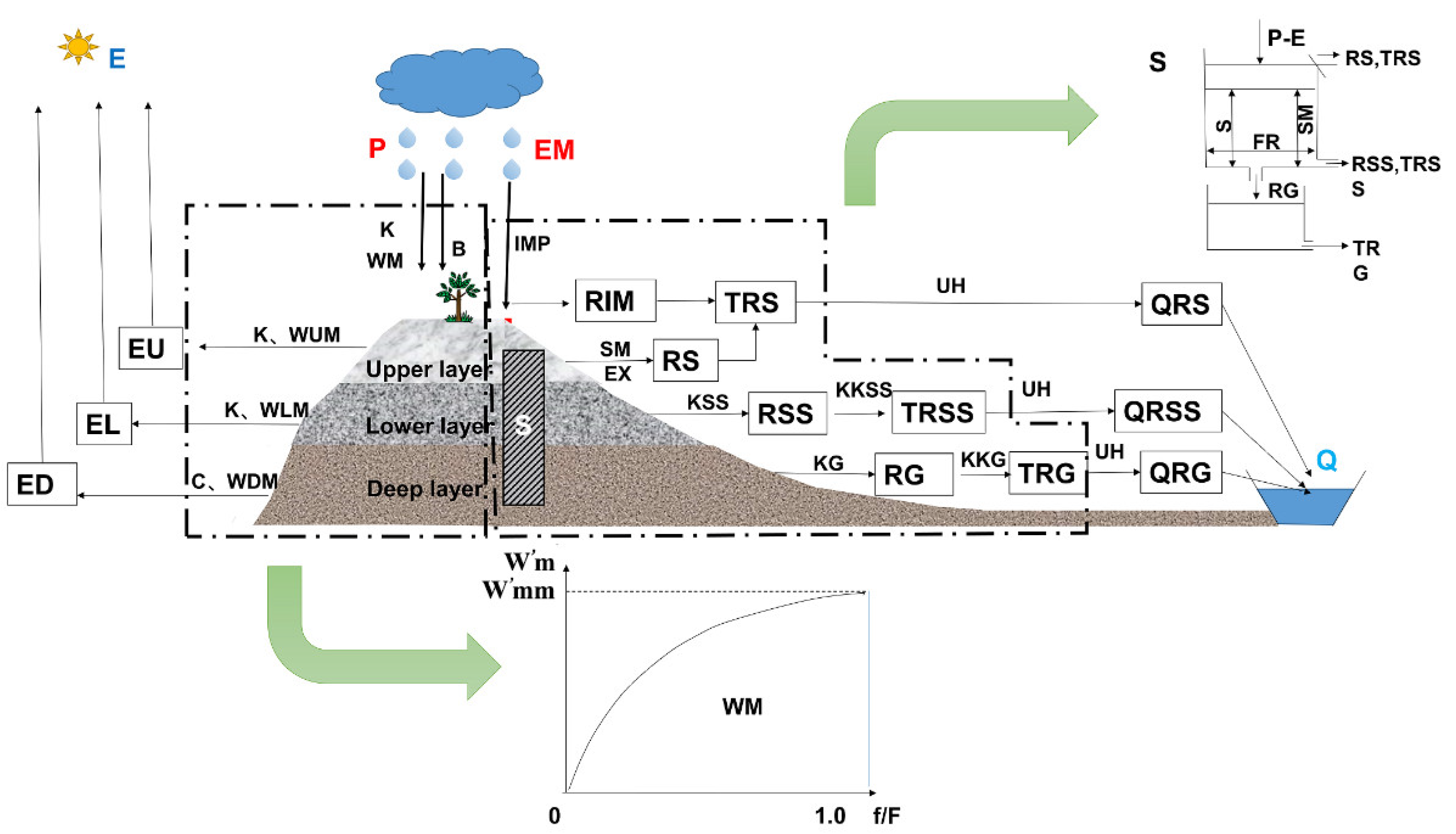


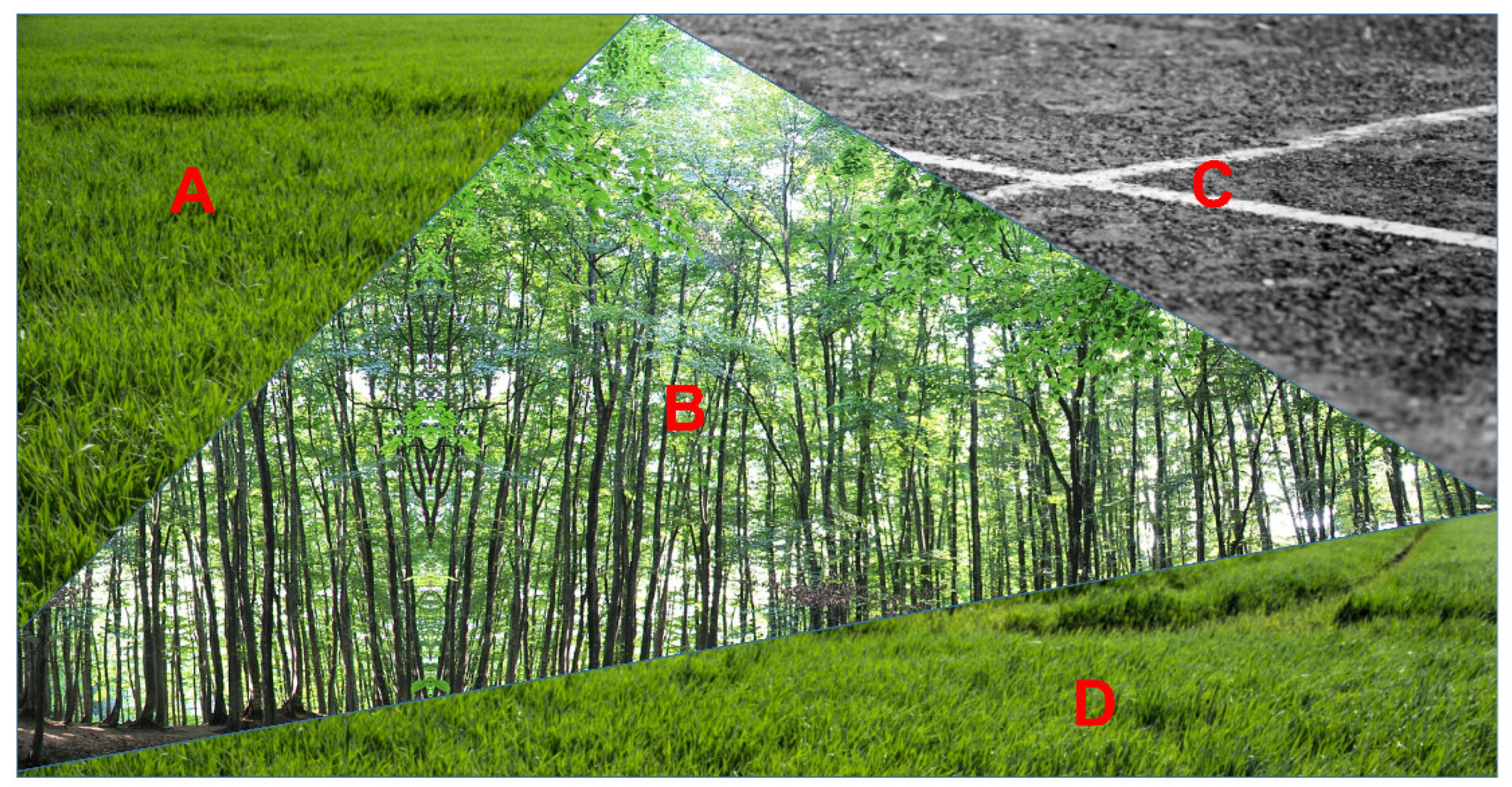
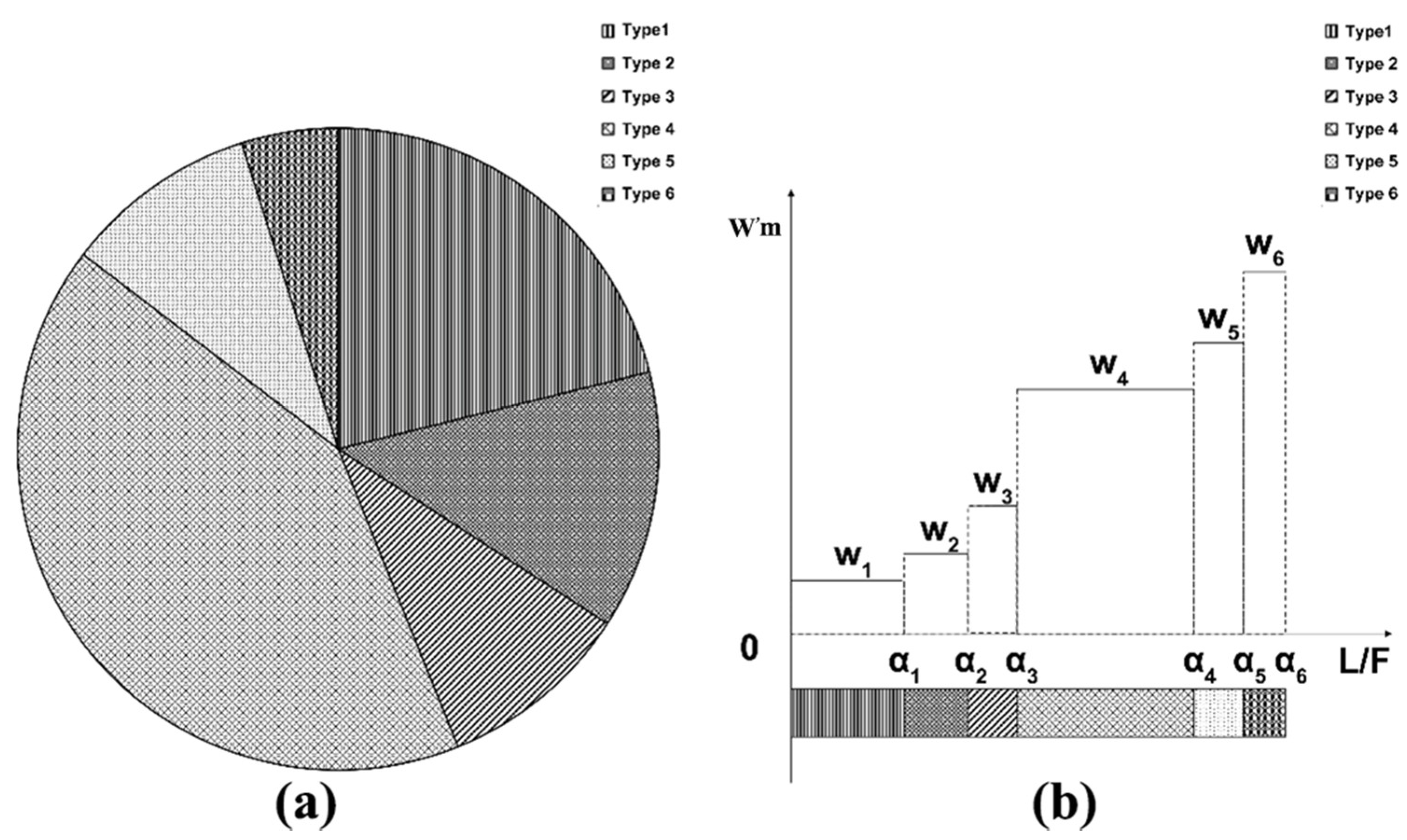
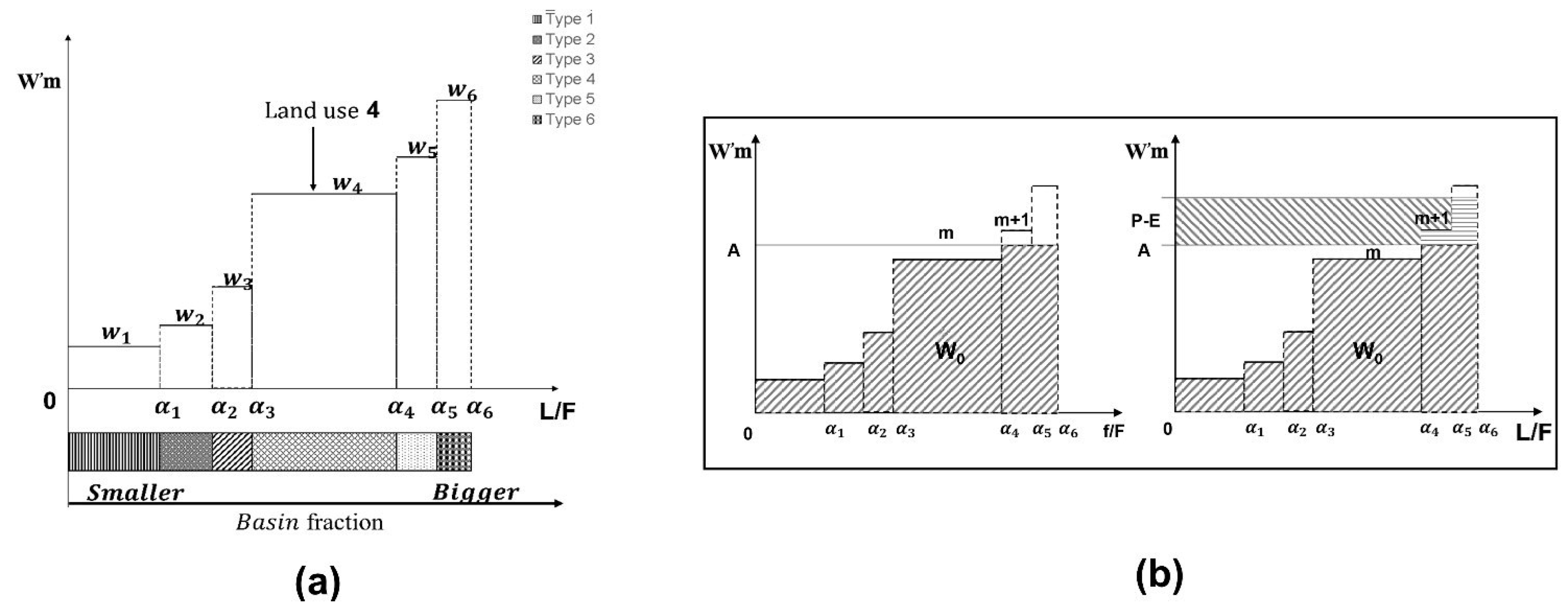
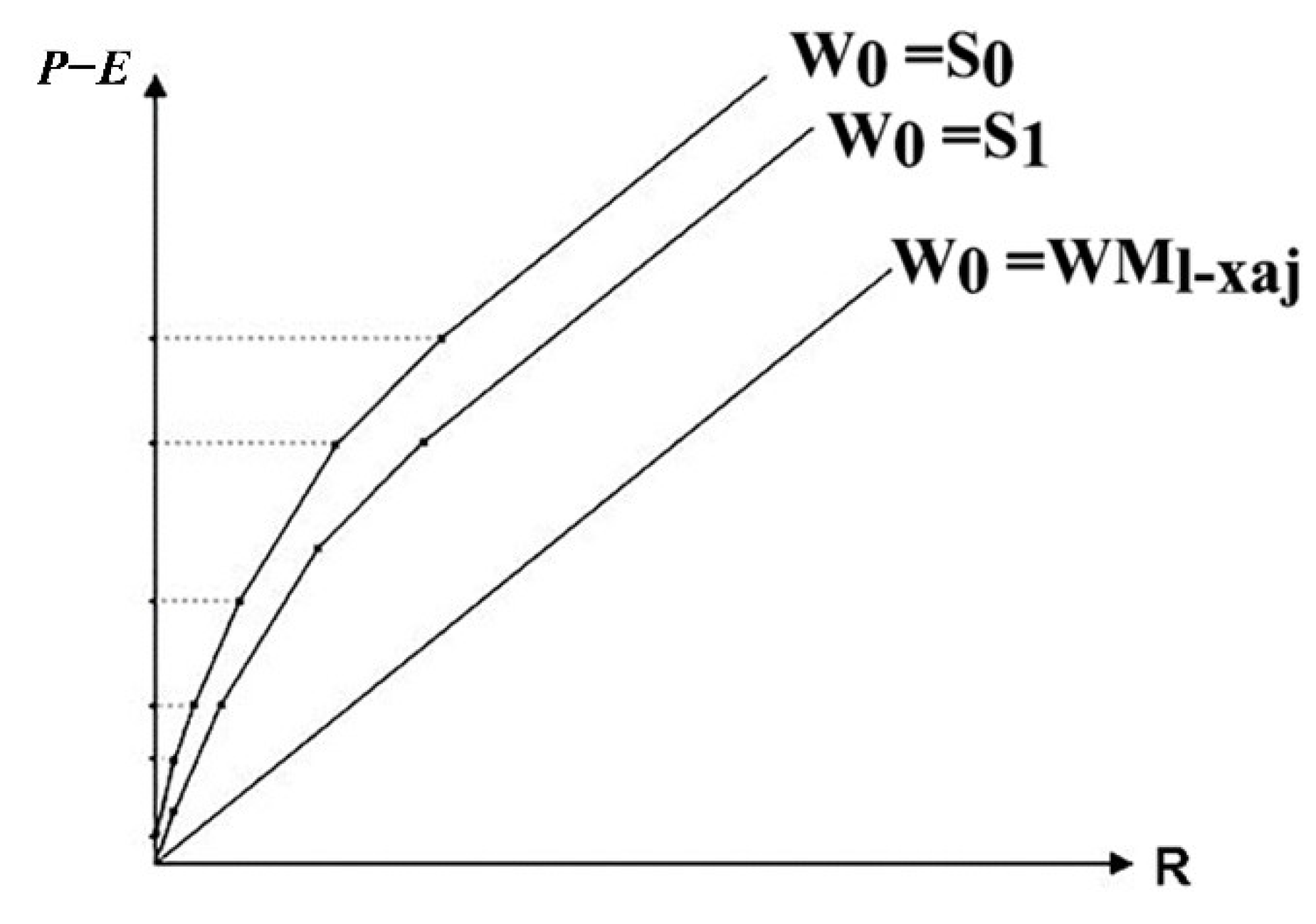
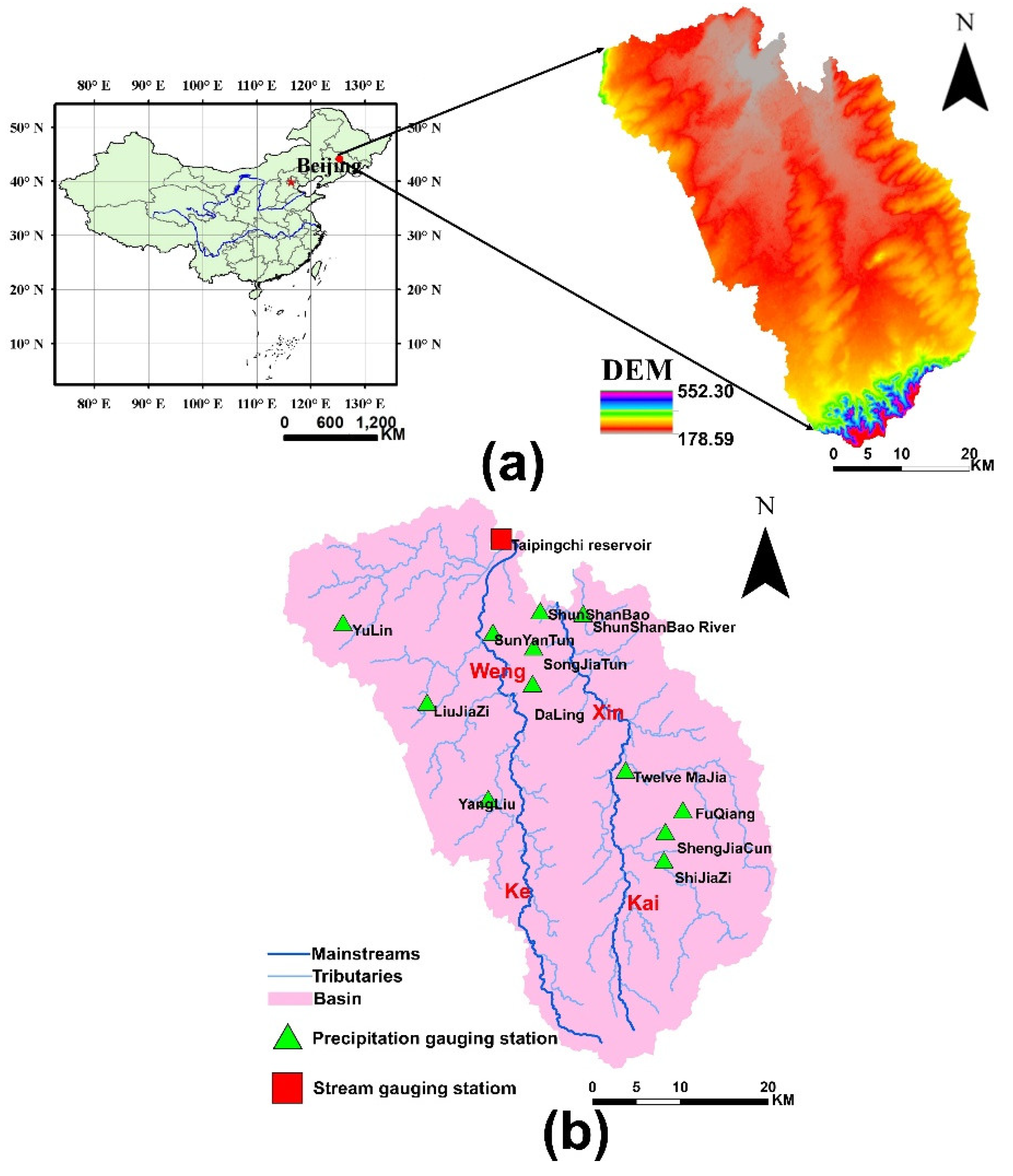
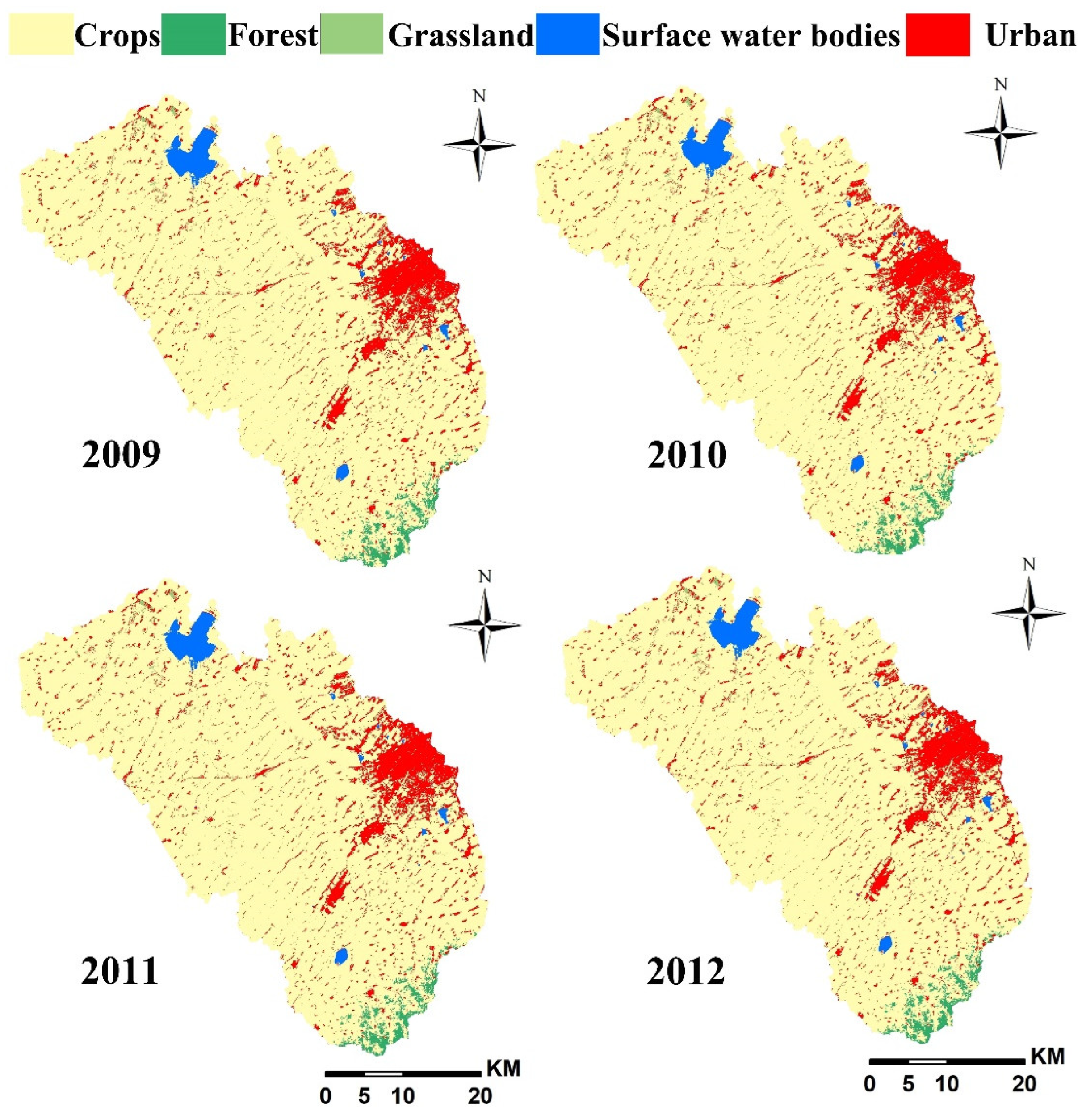
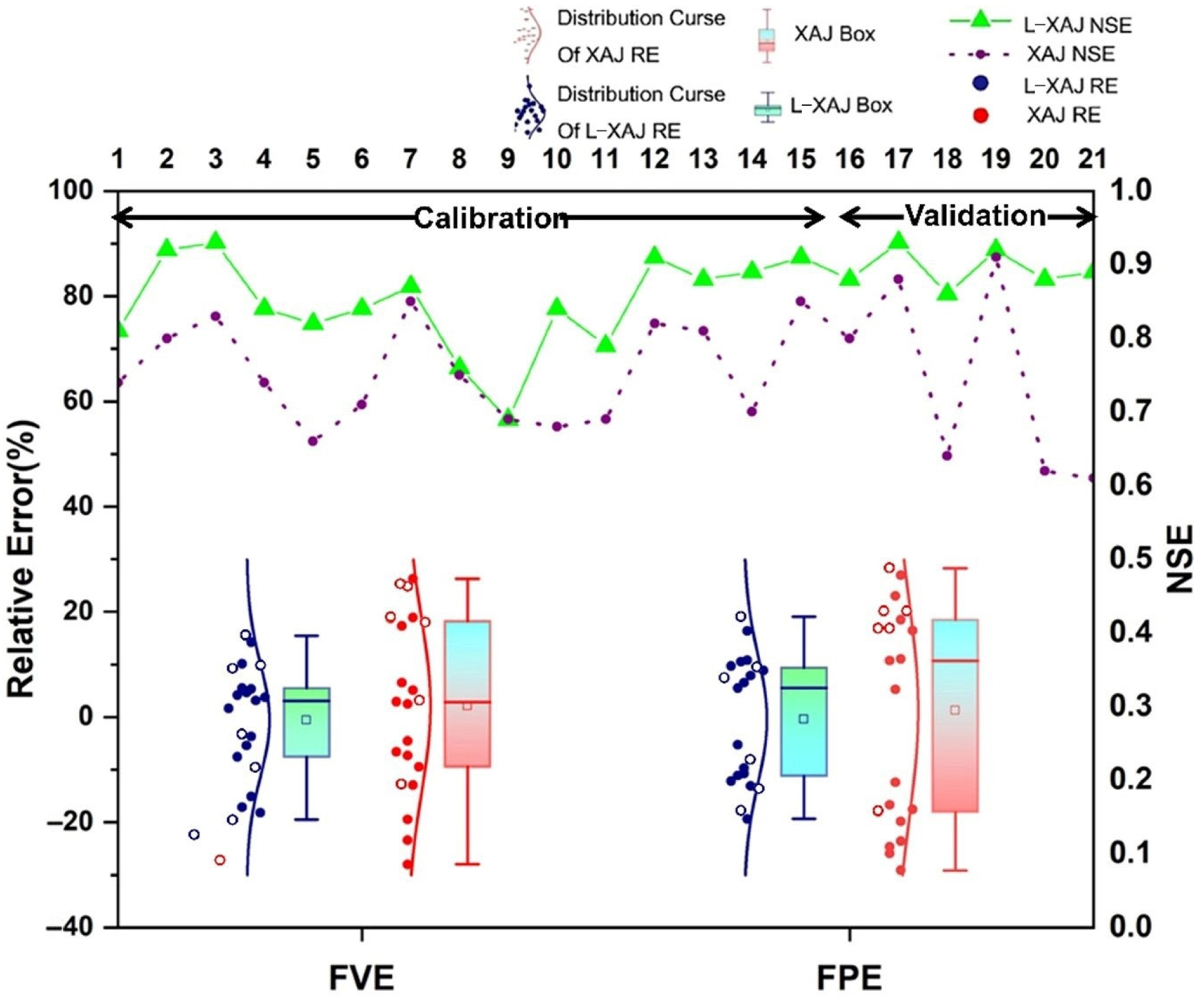
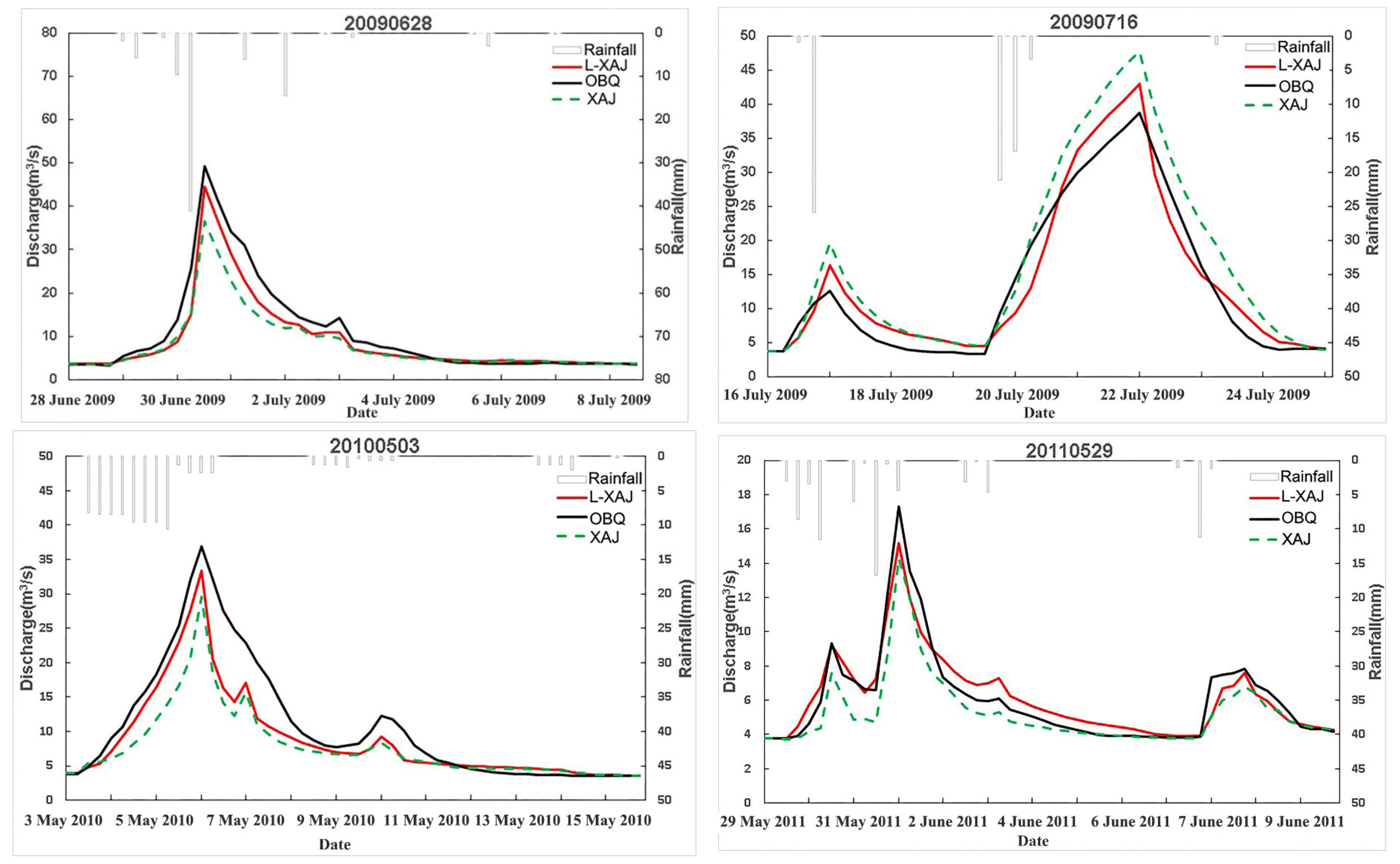
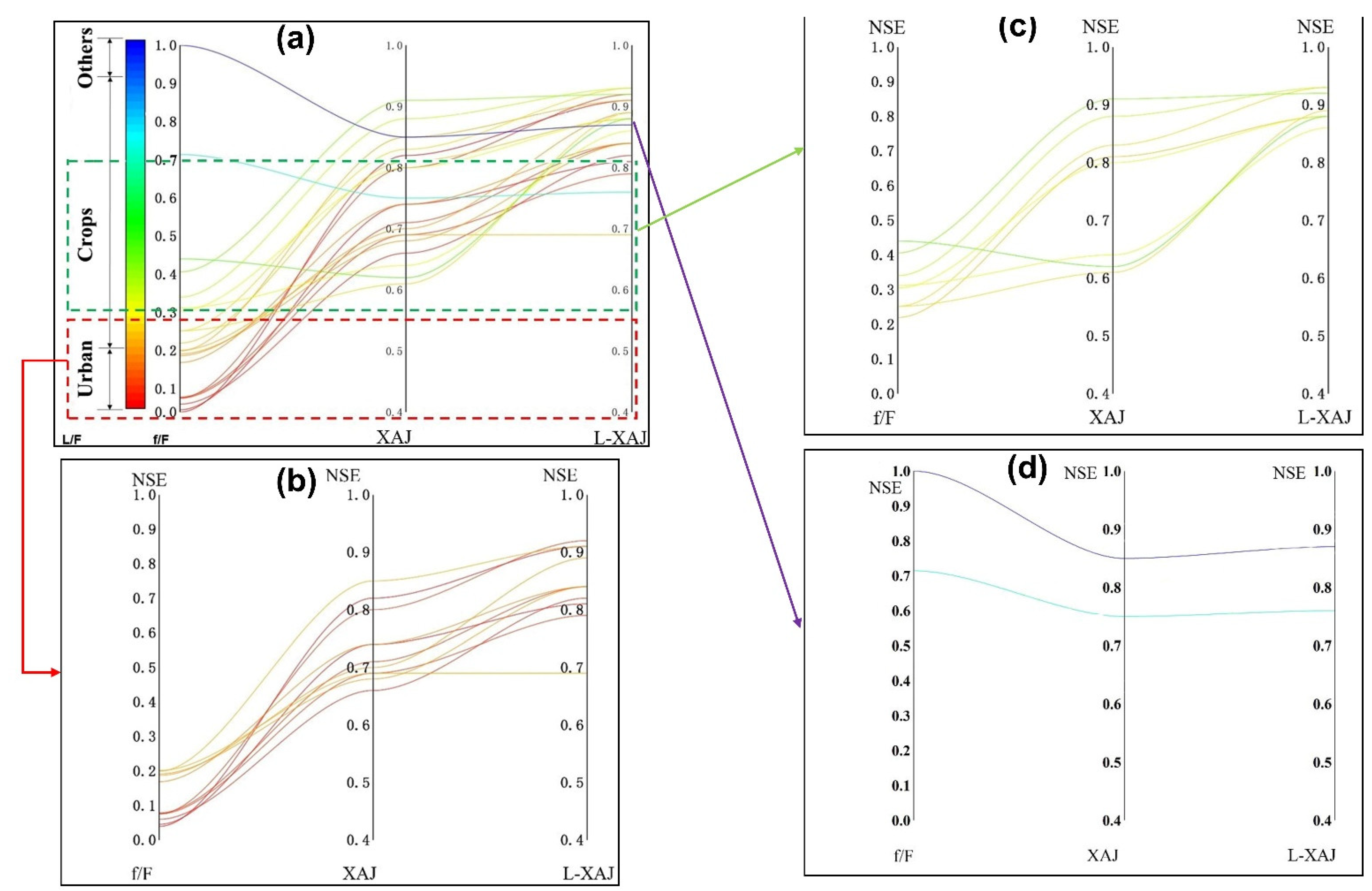
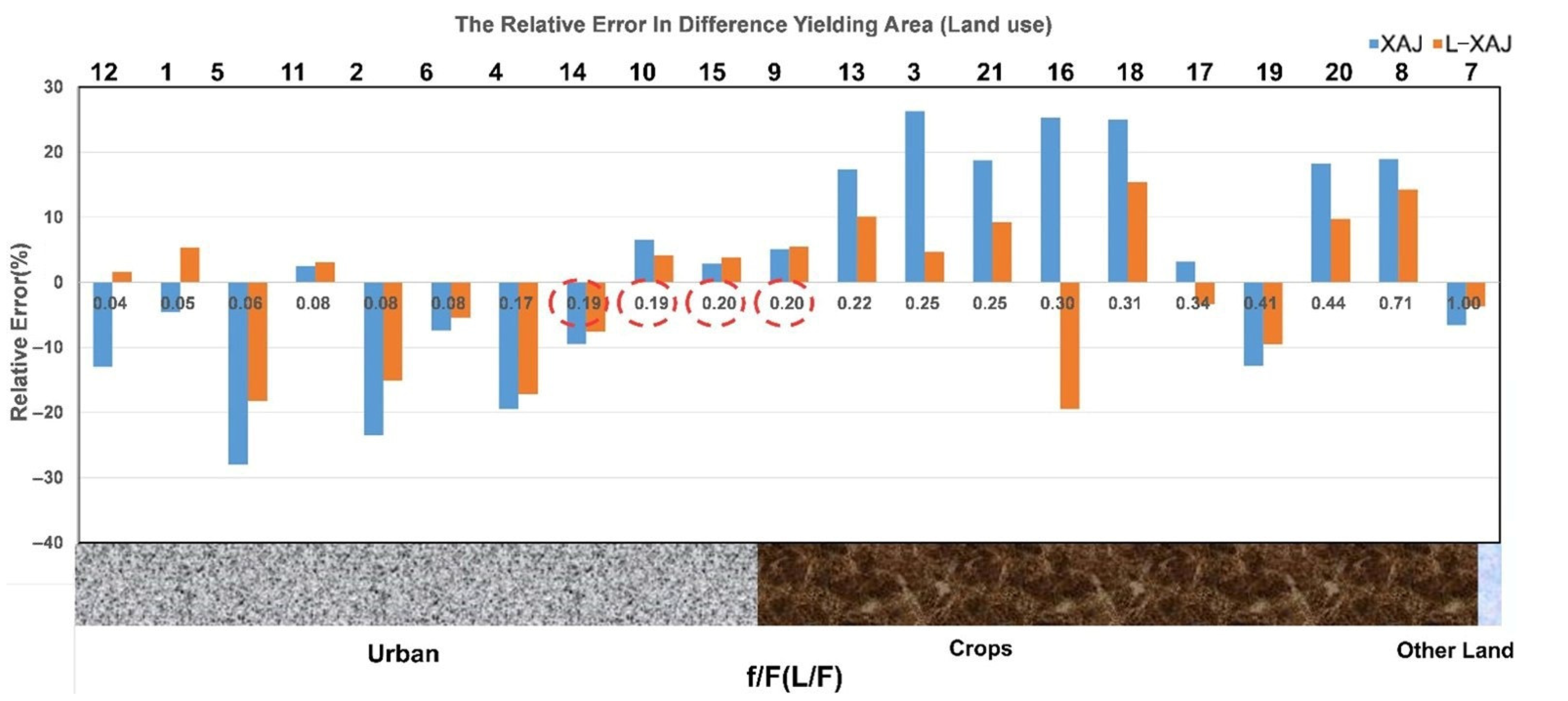
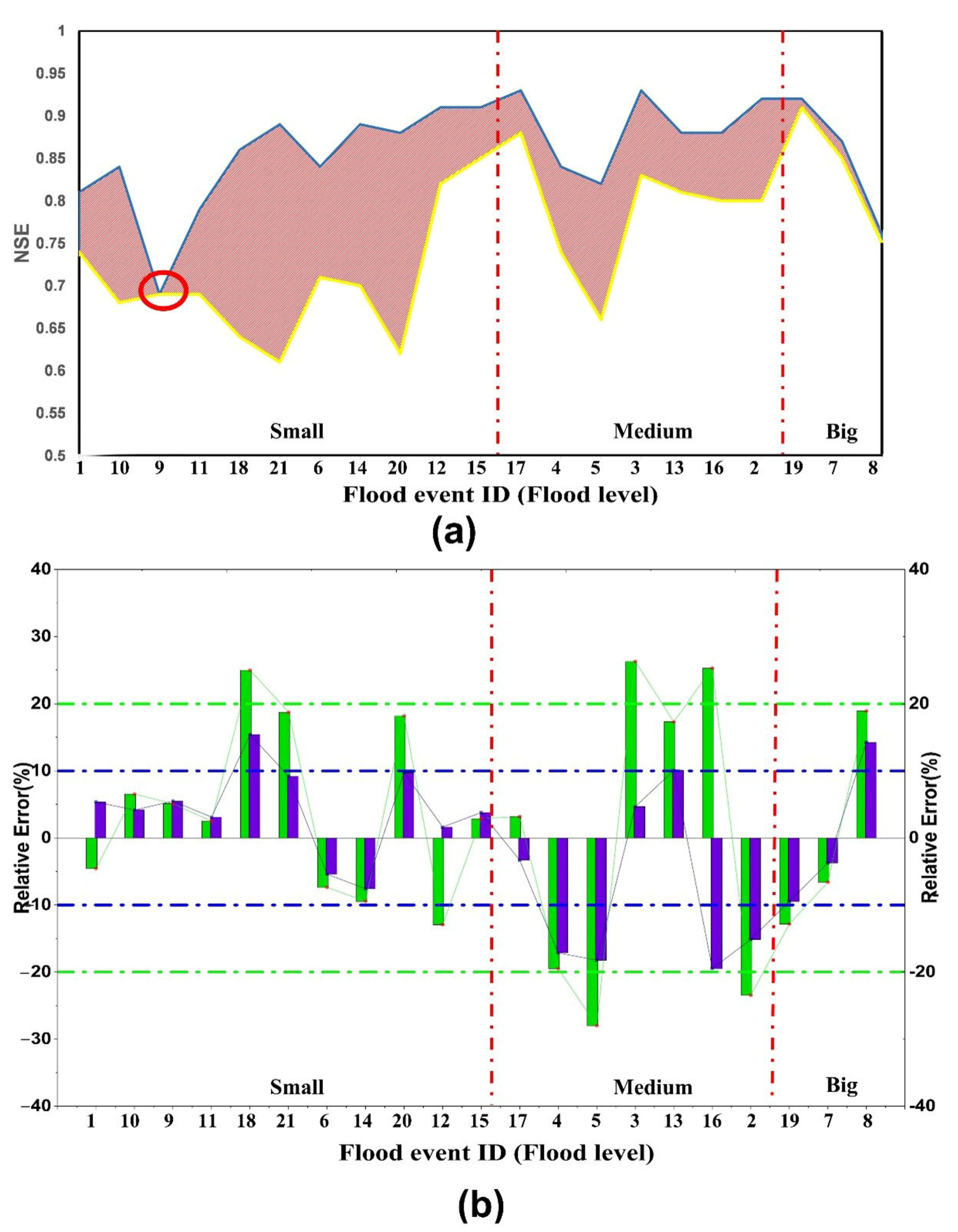
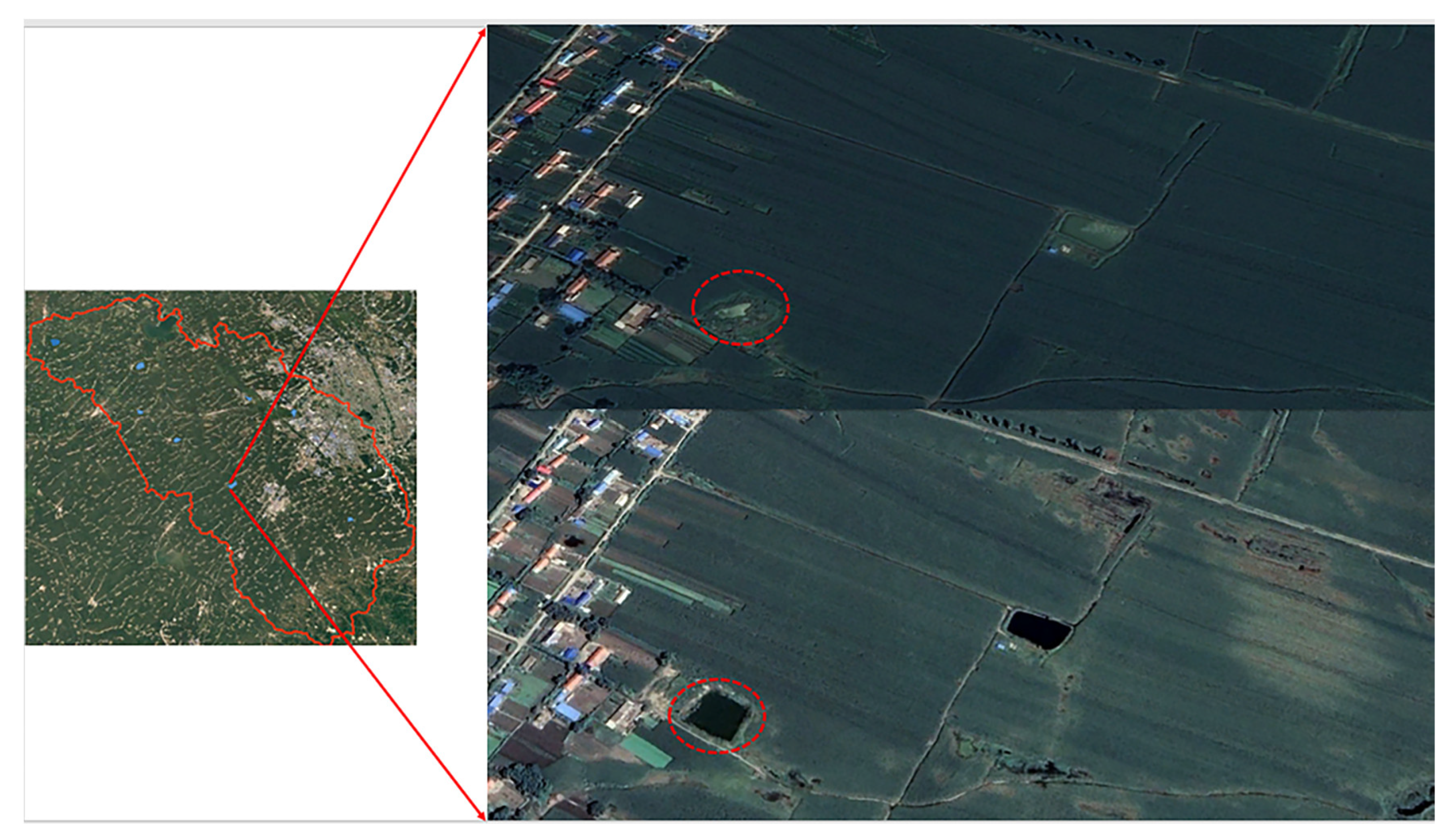

| Land-Use Type | 2009 | 2010 | 2011 | 2012 | ||||
|---|---|---|---|---|---|---|---|---|
| Area | Ratio (%) | Area | Ratio (%) | Area | Ratio (%) | Area | Ratio (%) | |
| Urban | 341.33 | 19 | 352.28 | 20 | 386.65 | 22 | 353.42 | 21 |
| Crops | 1308.77 | 77 | 1301.01 | 76 | 1267.46 | 74 | 1301.07 | 75 |
| Grassland | 4.64 | 1 | 4.01 | 1 | 3.52 | 1 | 3.11 | 1 |
| Forest | 23.4 | 1 | 21.7 | 1 | 21.6 | 1 | 21.71 | 1 |
| Surface water bodies | 28.53 | 2 | 27.67 | 2 | 27.44 | 2 | 27.36 | 2 |
| XAJ | L-XAJ | ||||
|---|---|---|---|---|---|
| Parameters | Value | Physical Meaning | Parameters | Value | Physical Meaning |
| WUM | 15.2 | Averaged soil moisture storage capacity of the upper layer | W1 | 0 | Urban land soil moisture storage capacity |
| WLM | 78.6 | Averaged soil moisture storage capacity of the lower layer | W2 | 153.3 | Cultivated land soil moisture storage capacity |
| WDM | 29.5 | Averaged soil moisture storage capacity of the deep layer | Ra1 | 0.2 | Area ratio of urban land |
| B | 0.35 | Exponential of the distribution to tension water capacity | Ra2 | 0.8 | Area ratio of cultivated land |
| K | 0.71 | Conversion coefficient of evaporation | K | - | - |
| C | 0.2 | Coefficient of the deep layer | C | - | - |
| IMP | 0.02 | Percentage of impervious and saturated areas in the basin | IMP | - | - |
| SM | 32.5 | Areal mean free water capacity of the surface soil layer | SM | - | - |
| EX | 1.02 | Exponent of the free water capacity curve influencing the development of the saturated area | EX | - | - |
| KG | 0.06 | Outflow coefficients of the free water storage to groundwater relationships | KG | - | - |
| KSS | 0.11 | Outflow coefficients of the free water storage to interflow relationships | KSS | - | - |
| KKG | 0.98 | Recession constants of the groundwater storage | KKG | - | - |
| KKSS | 0.71 | Recession constants of the lower interflow storage | KKSS | - | - |
| Period | Flood Event ID | Date | L-XAJ | XAJ | P | ||||
|---|---|---|---|---|---|---|---|---|---|
| NSE | FVE (%) | FPE (%) | NSE | FVE (%) | FPE (%) | ||||
| 1 | 28 May 2009 | 0.81 | 5.36 | 16.33 | 0.74 | −4.55 | −29.16 | + | |
| 2 | 28 June 2009 | 0.92 | −15.13 | −19.38 | 0.80 | −23.46 | −25.92 | + | |
| 3 | 16 July 2009 | 0.93 | 4.66 | 10.84 | 0.83 | 26.27 | 23.04 | + | |
| 4 | 27 August 2009 | 0.84 | −17.14 | −10.73 | 0.74 | −19.49 | −23.56 | + | |
| 5 | 3 May 2010 | 0.82 | −18.23 | −9.75 | 0.66 | −27.99 | −19.87 | + | |
| 6 | 1 July 2010 | 0.84 | −5.41 | −11.15 | 0.71 | −7.37 | −24.68 | + | |
| Calibration | 7 | 19 July 2010 | 0.87 | −3.73 | −13.15 | 0.85 | −6.59 | −16.68 | ⚬ |
| 8 | 4 August 2010 | 0.76 | 14.25 | −5.30 | 0.75 | 18.92 | 5.25 | ⚬ | |
| 9 | 10 October 2010 | 0.69 | 5.49 | 10.49 | 0.69 | 5.10 | 11.01 | ⚬ | |
| 10 | 11 November 2010 | 0.84 | 4.17 | 6.53 | 0.68 | 6.54 | 10.69 | + | |
| 11 | 18 May 2011 | 0.79 | 3.11 | 5.52 | 0.69 | 2.52 | −12.39 | + | |
| 12 | 29 May 2011 | 0.91 | 1.62 | −12.19 | 0.82 | −12.93 | −17.57 | + | |
| 13 | 30 June 2011 | 0.88 | 10.07 | 7.90 | 0.81 | 17.32 | 18.48 | + | |
| 14 | 20 July 2011 | 0.89 | −7.57 | 9.73 | 0.70 | −9.45 | 26.95 | + | |
| 15 | 30 July 2011 | 0.91 | 3.79 | 9.38 | 0.85 | 2.87 | 16.85 | + | |
| 16 | 29 June 2012 | 0.88 | −19.48 | −17.83 | 0.80 | 25.28 | 20.26 | + | |
| 17 | 22 July 2012 | 0.93 | −3.32 | −13.45 | 0.88 | 3.18 | −18.04 | + | |
| Validation | 18 | 18 August 2012 | 0.86 | 15.42 | −8.02 | 0.64 | 24.97 | 16.41 | + |
| 19 | 27 August 2012 | 0.92 | −9.47 | 19.09 | 0.91 | −12.83 | 17.01 | ⚬ | |
| 20 | 27 September 2012 | 0.88 | 9.74 | 7.42 | 0.62 | 18.20 | 28.31 | + | |
| 21 | 10 November 2012 | 0.89 | 9.20 | 8.82 | 0.61 | 18.75 | 20.22 | + | |
Publisher’s Note: MDPI stays neutral with regard to jurisdictional claims in published maps and institutional affiliations. |
© 2022 by the authors. Licensee MDPI, Basel, Switzerland. This article is an open access article distributed under the terms and conditions of the Creative Commons Attribution (CC BY) license (https://creativecommons.org/licenses/by/4.0/).
Share and Cite
Xu, C.; Fu, H.; Yang, J.; Wang, L.; Wang, Y. Land-Use-Based Runoff Yield Method to Modify Hydrological Model for Flood Management: A Case in the Basin of Simple Underlying Surface. Sustainability 2022, 14, 10895. https://doi.org/10.3390/su141710895
Xu C, Fu H, Yang J, Wang L, Wang Y. Land-Use-Based Runoff Yield Method to Modify Hydrological Model for Flood Management: A Case in the Basin of Simple Underlying Surface. Sustainability. 2022; 14(17):10895. https://doi.org/10.3390/su141710895
Chicago/Turabian StyleXu, Chaowei, Hao Fu, Jiashuai Yang, Lingyue Wang, and Yizhen Wang. 2022. "Land-Use-Based Runoff Yield Method to Modify Hydrological Model for Flood Management: A Case in the Basin of Simple Underlying Surface" Sustainability 14, no. 17: 10895. https://doi.org/10.3390/su141710895
APA StyleXu, C., Fu, H., Yang, J., Wang, L., & Wang, Y. (2022). Land-Use-Based Runoff Yield Method to Modify Hydrological Model for Flood Management: A Case in the Basin of Simple Underlying Surface. Sustainability, 14(17), 10895. https://doi.org/10.3390/su141710895







